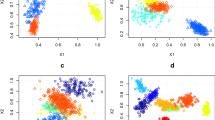Abstract
In this paper, we study a robust and efficient estimation procedure for the order of finite mixture models based on the minimizing a penalized density power divergence estimator. For this task, we use the locally conic parametrization approach developed by Dacunha-Castelle and Gassiate (ESAIM Probab Stat 285–317, 1997a; Ann Stat 27:1178–1209, 1999), and verify that the minimizing a penalized density power divergence estimator is consistent. Simulation results are provided for illustration.
Similar content being viewed by others
References
Akaike H (1973) Information theory and an extension of the maximum likelihood principle. In: Petrov BN, Csaki F (eds) Second international symposium on information theory, pp 267–281
Basu A, Harris IR, Hjort NL and Jones MC (1998). Robust and efficient estimation by minimizing a density power divergence. Biometrika 85: 549–559
Beran R (1977). Minimum hellinger distance estimates for parametric models. Ann Stat 5: 445–463
Chen J and Kalbfleisch JD (1996). Penalized minimum distance estimates in finite mixture models. Can J Stat 24: 167–175
Cressie N and Read TRC (1984). Multinomial goodness-of-fit tests. J R Stat Soc B 5: 440–454
Csiszar I (1963) Eine Informationstheoretische Ungleichung und ihre Anwendung auf den Bewis der Ergodizitat on Markhoffschen Ketten. Publication of the Mathematical Institute of the Hungarian Academy of Sciences, vol 8, pp 84–108
Dacunha-Castelle D, Gassiate E (1997a) Testing in locally conic models and application to mixture models. ESAIM Probab Stat 285–317
Dacunha-Castelle D and Gassiate E (1997b). The estimation of the order of a mixture model. Bernoulli 3: 279–299
Dacunha-Castelle D and Gassiate E (1999). Testing the order of a model using locally conic parametrization: population mixtures and stationary arma processes. Ann Stat 27: 1178–1209
Demsper AP, Laird NM and Rubin DB (1977). Large Maximum-likelihood from incomplete data via the EM algorithm. J R Stat Soc Ser B 39: 1–38
Dudley RM and Philipp W (1983). Variance principles for sums of Banach space valued random elements of empirical processes. Z Warsch Verw Gebi 62: 509–552
Fujisawa H and Eguchi S (2007). Robust estimation in the normal mixture model. J Stat Plan Inference 136: 3989–4011
Furman WD and Lindsay BG (1994). Testing for the number of components in a mixture of normal distributions using moment estimators. Comput Stat Data Anal 17: 473–492
Gassiat E (2002). Likelihood ratio inequalities with applications to various mixtures. Ann de l’ Inst Henri Poincaré 38: 897–906
Heckman JJ, Robb R and Walker JR (1990). Testing the mixture of exponentials hypothesis and estimating the mixing distribution by the method of moments. J Am Stat Assoc 85: 582–589
Henna J (1985). On estimating the number of constituents of a finite mixture of continuous distributions. Ann Inst Stat Math 37: 235–240
Hjort NL (1994) Minimum L2 and robust Kullback-Leibler estimation. In: Lachout P, Vis̃ek JÁ (eds) Proceedings of the 12th Praque conference on information theory, statistical decision functions and random processes. Prague Academy of Sciences of the Czech Republic, pp 102–105
Hong C and Kim Y (2001). Automatic selection of the tuning parameter in the minimum density power divergence estimation. J Korean Stat Soc 30: 453–465
Izenman AJ, Sommer C (1988) Philatic mixtures and multivariate densities. J Am Math Soc 83–94
James LF, Priebe CE and Marchette DJ (2001). Consistent estimation of mixture complexity. Ann Stat 29: 1281–1296
Keribin C (2000). Consistent estimation of the order of mixture models. Sankhyā 62: 49–66
Leroux BG (1992). Consistent estimation of a mixing distribution. Ann Stat 20: 1350–1360
Lindsay BG (1983). Moment matrices: application in mixtures. Ann Stat 17: 722–740
Liu X and Shao Y (2003). Asymptotics for likelihood ratio tests under loss of identifiability. 31: 807–832
Mattheou K, Lee S, Karagrigourio A (2008) The BHHJ measure: properties, characterizations, goodness of fit tests and model selection. J Stat Plan Inference (accepted)
Pardo L (2006). Statistical inference based on divergence measures. Chapman and Hall/CRC, London/Boca Raton
Priebe CE and Marchette DJ (2000). Alternating kernel and mixture density estimates. Comput Stat Data Anal 35: 43–65
Redner R and Walker HF (1984). Mixture densities, maximum likelihood and the EM algorithm. SIAM Rev 26: 195–239
Roeder K (1994). A graphical technique for determining the number of components in a mixture of normals. J Am Stat Assoc 89: 487–495
Schwarz G (1978). Estimating the dimension of a model. Ann Stat 6: 461–464
Scott DW (1998). Parametric modelling by minimum L2 error. TR 98-3. Rice University, Houston
Scott DW (2001). Parametric statistical modelling by minimum integrated square error. Technometrics 43: 274–285
Tamura R and Boos D (1986). Minimum hellinger distance estimation for multivariate location and covariance. J Am Stat Assoc 81: 223–229
Teicher H (1965). Identifiability of finite mixtures. Ann Math Stat 36: 423–439
Terrell GR (1990) Linear density estimates. In: Proceeding in the statistical computing section. Am Stat Assoc, pp 297–302
Van der vart AW and Wellner JA (1996). Empirical processes. Springer, Berlin
Warwick J and Jones MC (2005). Choosing a robustness tuning parameter. J Stat Comput Simul 75: 581–588
Woodward WA, Parr WC, Schucany WR and Lindsay H (1984). A comparison of minimum distance and maximum likelihood estimation of a mixture proportion. J Am Stat Assoc 79: 590–598
Yakowitz SJ and Spragins JA (1968). On the identifiability of finite mixtures. Ann Math Stat 39: 209–214
Author information
Authors and Affiliations
Corresponding author
Rights and permissions
About this article
Cite this article
Lee, S., Lee, T. Robust estimation for the order of finite mixture models. Metrika 68, 365–390 (2008). https://doi.org/10.1007/s00184-007-0168-x
Received:
Published:
Issue Date:
DOI: https://doi.org/10.1007/s00184-007-0168-x




